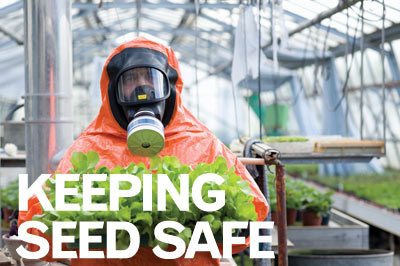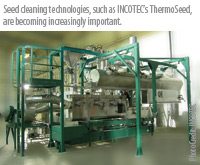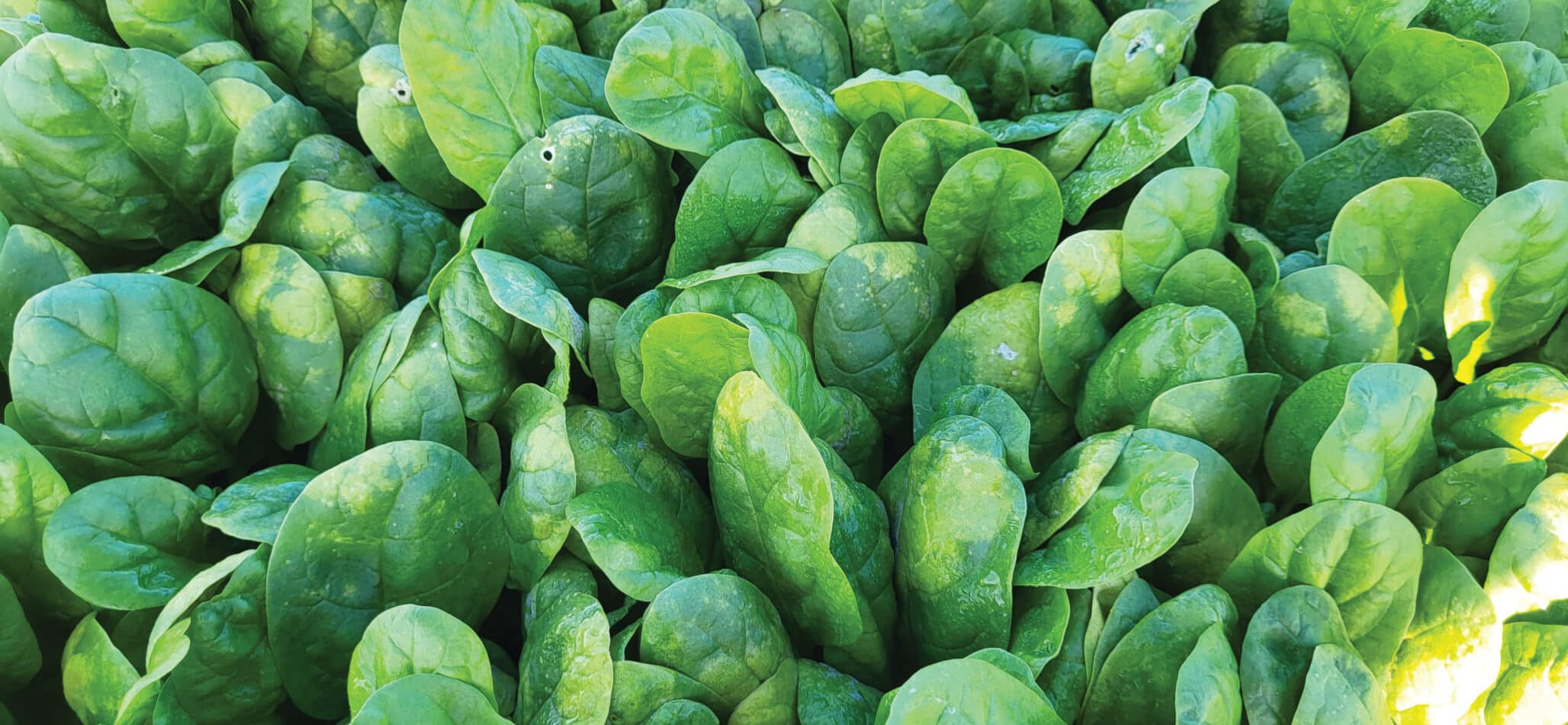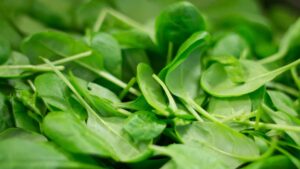Few connections have been made between seed and the contamination of food, but seed industry members, who feel the impact of every food safety scare with decreased seed sales, are invested in improving traceability mechanisms—and continuing to keep seed safe.
Since the catastrophic E. coli spinach outbreak of 2006, which sickened hundreds and killed three, if you mention the word “E. coli” to a spinach seed grower they will likely turn a whiter shade of pale. In the wake of the outbreak, says Stokes Seeds president Wayne Gale, “We saw a dramatic drop in our spinach sales, and I know a number of other seed dealers saw huge drops for about a year or two.”
The E. coli 0157:H7 outbreak, which originated in the Salinas Valley in California, “was a disaster” for spinach growers, according to Gale. “People went broke. We even saw [the impact] up in Canada. [Produce] shipments were being refused. The contamination was on the West Coast but even East Coast sellers suffered dramatically,” he says.
Seed was not implicated in the 2006 contamination—the cause was presumed to be contaminated surface runoff from a livestock operation—but demand for spinach disappeared virtually overnight, and the seed industry suffered. These days, spinach is making a comeback, but food safety scares regularly appear in the media. And as the public turns its attention to the increased need for food safety and traceability measures all along the food chain, the seed industry is included by default.
“I’m seeing more requests to sign some form of document that says that our seed is kept in an environment without rodents and insects and is packed in a manner that is suitable for seed, those types of things,” says Gale. “A lot of them don’t particularly apply to the seed industry—it’s a bit tricky. I sometimes have to make the stipulation that our seed is treated. But seed is not food in and of itself, so we’re on the fringe of the current ISO-type quality management systems.”
How Safe is Your Seed?
Ric Dunkle, senior director of seed health and trade for the American Seed Trade Association, says the California E. coli outbreak caused the seed industry to become aware of the impacts on the industry if seed were ever to be implicated in a food safety crisis. “It promoted a heightened awareness of the potential effect that some food safety pathogens may have on seed,” he says. “Whether those are actual or perceived threats—I think that’s the issue.”
One area where seed has been implicated in the contamination of food is with seed used for the production of sprouts. “In the sprout industry, seed is brought into a greenhouse where it is germinated and maintained under warm and humid conditions,” explains Dunkle. “So if there are pathogens that have hitchhiked onto that seed, those environments are very conducive to pathogens.”
However, Dunkle says the sprout industry is extremely aware of the potential risks, and has made every effort to control those risks. “Seed is produced carefully and tested to prevent any source of outbreaks associated with that seed,” he says. “But the thing we want to emphasize is that whenever there’s an outbreak with sprouts, the sources of inoculum are sources other than seed—as when employees don’t wash their hands.”
When it comes to seed that is planted, there is no evidence suggesting that pathogens on the seed can be transmitted to the growing plant and eventually the produce. In fact, a statement on the safety of vegetables and produce planted from seed, released by ASTA last July, re-emphasized the results of multiple studies that have examined the potential contamination of produce from E. coli-tainted seed. “We know from a number of research studies that even when seed is intentionally contaminated with E. coli and planted in the ground, the bacteria is not transmitted to the produce harvested,” said Trevor Suslow, University of California—Davis food safety specialist, in the release.
Nevertheless, ASTA is taking no chances, despite repeated statements released by the organization that there is “no significant value in testing seed lots for the presence of human pathogens.” Following the 2006 outbreak, it established the Food Safety Pathogen Working Group, comprised of food safety experts and industry representatives.
According to Dunkle, who coordinates the working group, “this group reviews and maintains an awareness of what’s going on in the scientific arena, reviews any publications coming out on the implications of pathogens on seed, and also reviews outbreaks in the plant arena to determine whether we have to worry about these things for seed.” Any pertinent information on seed safety gleaned by the working group is posted to ASTA’s website for members.
“If there’s an outbreak with implications for seed, we have a rapid response, if you will,” says Dunkle.
“Clean Enough to Eat”
In the last several years, seed cleaning technologies and businesses have increased. In the global environment of increasing concern for safety and traceability from seed to plate, will there be an increasing role for seed cleaning technologies with regard to removing human pathogens from seed? That shift would have special relevance for those in the vegetable seed and sprout market.
INCOTEC, the international coating and seed technology group, provides a range of technologies for commercial seed cleaning, including their Brassica priming treatment eXccit, which removes bacteria from the seed. INCOTEC’s newest offering is ThermoSeed, a thermal disinfection process which uses hot humid air to “pasteurize” the seed and destroy fungi and certain bacteria. “ThermoSeed-treated seed is the cleanest seed in the world,” says David Pickenpaugh, president and general manager of INCOTEC USA. “It’s a very efficient [process, and] the thing we really like about it is that it’s environmentally friendly—you can eat the seed it’s so clean.” While the technology has only been used commercially in the Baltic area, INCOTEC will soon be cutting the ribbon on a smaller machine at its U.S. headquarters in Salinas, Calif. “It will be a small machine that we’ll start trials with in-field seed, and we’ll also be trialing it on vegetable seed—spinach, onions and carrots,” says Pickenpaugh. ThermoSeed technology can kill verticillium and other pathogens—but only additional testing will tell whether it kills E. coli and other human pathogens. “We have not completed testing for its effectiveness against E. coli,” says Pickenpaugh. “The technology was not developed for food safety—however, it may have application in those areas and testing will be done.”
“Everyone should do whatever they can to [create] traceability, so that seed producers, dealers and sellers can track seed from cradle to grave.”
Even if the technology proves to be efficacious against human pathogens like E. coli, it goes without saying that seed cleaning can only be part of a greater package of best management practices if outbreaks are to be averted. But Pickenpaugh sees only benefits to seed cleaning. “The thing that is very interesting is this new process of being able to remove pathogens from seed using hot humid air, without killing the seed. I think it does a lot of things for the grower—it provides seed with any diseases or pathogens gone right off the bat. It gives the grower an advantage,” he says.
As to whether the seed industry can reinforce consumer confidence in food safety, Pickenpaugh is convin
ced it is doing everything possible to avert a crisis. “The level of stewardship is very high for this [issue],” he says. “ASTA has been forthcoming with their position on it. The California Seed Association has also been proactive. Now, Europe is doing the same. It’s very concerning to us.”
Barcoding the Banana
Seed industry members have a vested interest in keeping seed safe, whether or not seed is directly implicated in outbreaks of food- borne illnesses. As yet, there is no government legislation in place that requires seed companies to implement traceability initiatives, but many seed companies are already moving in that direction.
“To my knowledge there are no formal traceability requirements enforced by the government, at least from a health perspective,” says Gale. “We do have requirements under the Federal Seed Act to do lot tracking back to an originator. If I sell a unit of seed I’m supposed to have the records to trace it back to a given supplier and to his lot number. But if a supplier comes to me and says a lot of seed has been contaminated, as far as I know, there is no regulation that says I have to be able to give him all the customers who [purchased] that [particular] lot.”
But Gale says customers are beginning to demand backward and forward traceability. As seed is essentially untraceable once it is removed from a package, seed dealers must be creative with their traceability solutions. Gale says many growers are beginning to barcode bins and use GPS to identify the fields and rows each batch came from.
Stokes Seeds can track all its seed products from the supplier to the customer and back again if necessary. “We’ve implemented a bar code and hand-held computer system that as every order is picked, our internal batch number is recorded,” he says. “If for some reason the seed is implicated in a food safety issue, with regard to presence of GM or some disease that can be communicated through the seed, we need to be able to trace it back with high reliability.”
Gale, who also has a degree in Computer Science from Waterloo University in Ontario, Canada, is conscious of the technological capabilities that exist for traceability, and believes the industry could utilize this potential to a greater degree. “The technology is there—all the pieces to the puzzle are out there, it’s just that the industry has to be able to organize the data and refine some of the barcoding and information transfer,” he says.
For all levels of the food chain, consumer education remains another important link. No matter how many safety and traceability measures are in place, seed companies may still suffer the next time an outbreak hits the news.
Dunkle believes the sharpening focus on food safety can be seen as a positive opportunity for the seed industry—but consumer education is key. “I think we need to do more to [communicate] to the public what goes on in the seed industry related to quality and production that is designed to prevent pathogens,” he says. “Any pathogen that impacts seed quality is of concern to the industry.”
Julienne Isaacs














